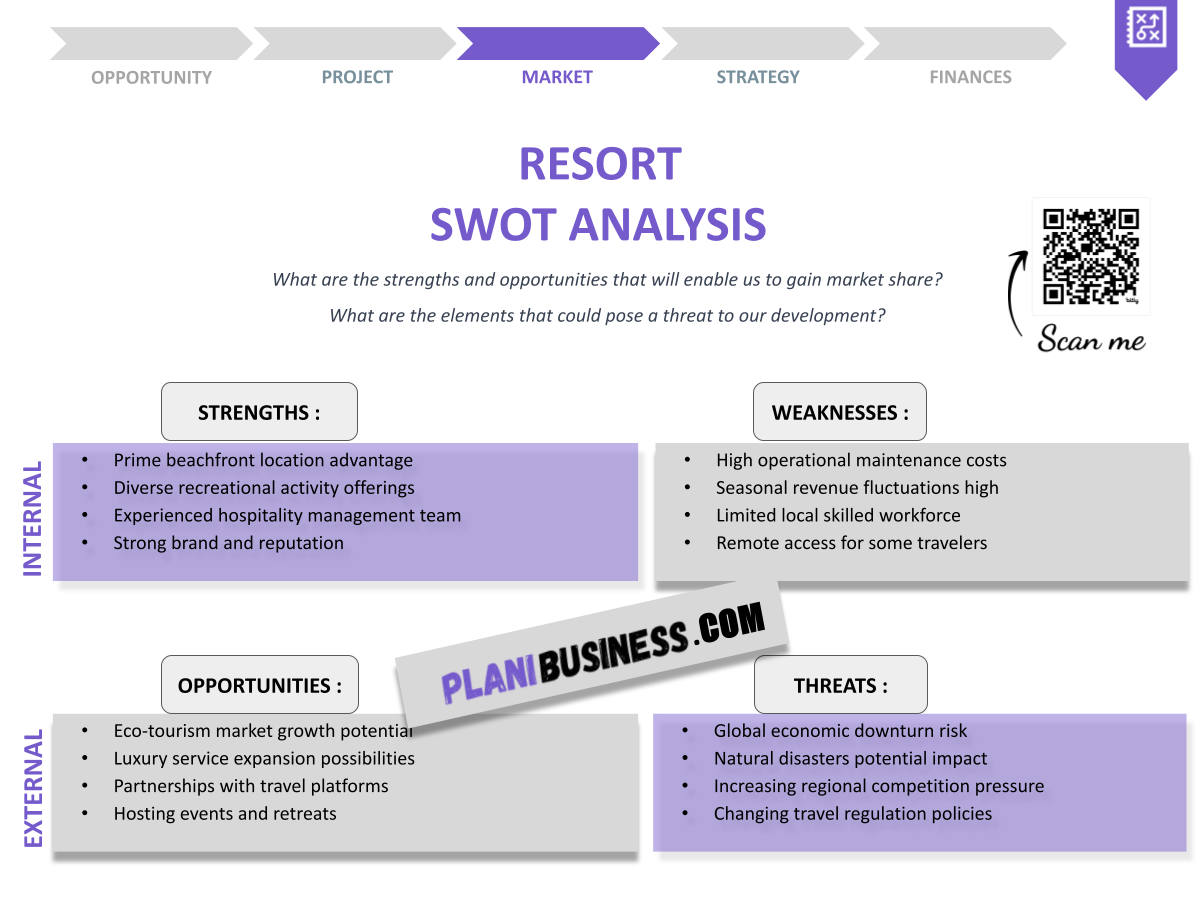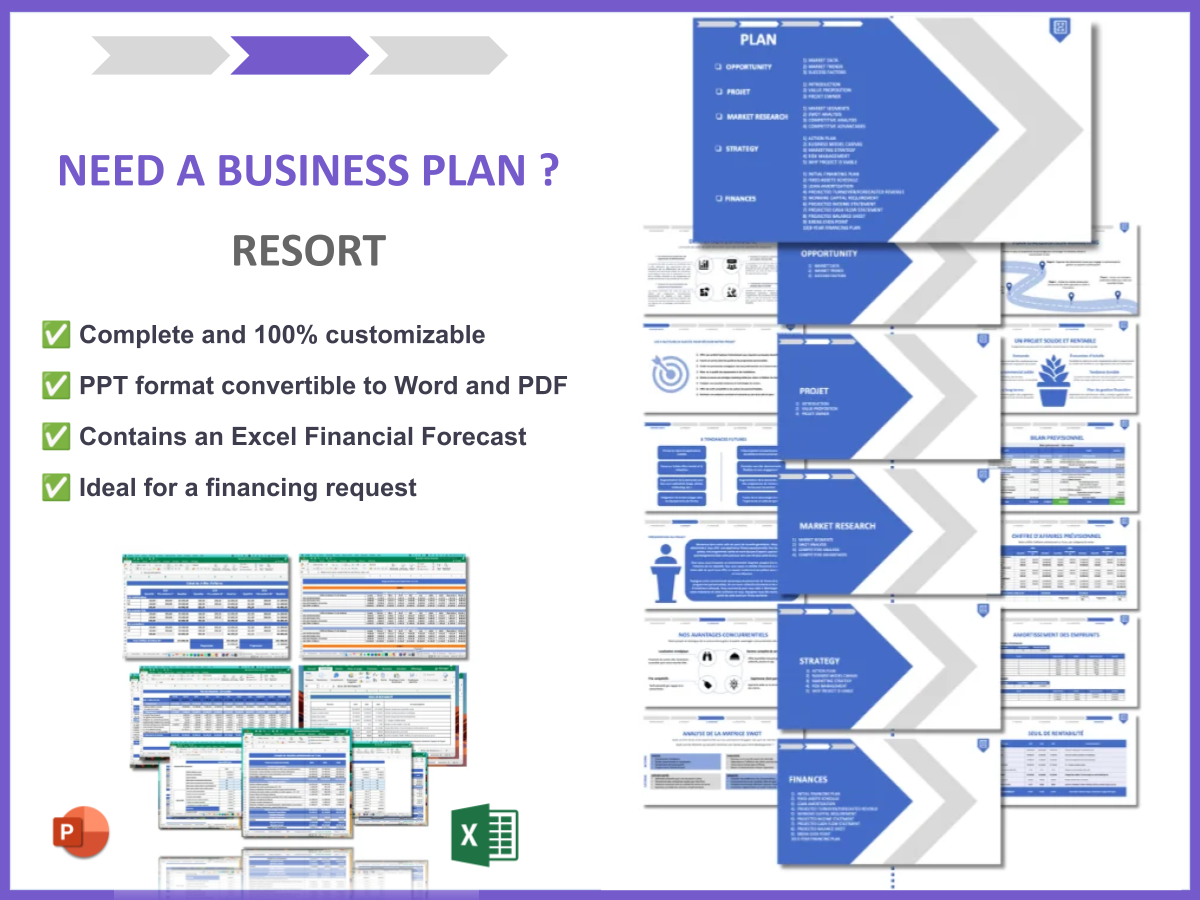Why Should You Have a SWOT Analysis for Your Resort?
Did you know that over 70% of resorts that conduct a SWOT analysis see a significant improvement in their strategic planning? A SWOT analysis for your resort is not just a good idea; it’s essential. It’s a simple yet powerful tool that helps you identify your strengths, weaknesses, opportunities, and threats. By understanding these elements, you can make informed decisions that can elevate your resort’s success.
A SWOT analysis is a structured planning method used to evaluate the internal and external factors that can impact your business. It allows you to focus on what you do well, recognize areas for improvement, explore new opportunities for growth, and prepare for potential threats in the competitive landscape.
- Understand the importance of SWOT analysis.
- Learn how to write a SWOT analysis for your resort.
- Explore 10 practical examples of SWOT analyses.
- Identify key strengths that can boost your resort’s appeal.
- Recognize weaknesses that need addressing.
- Discover opportunities for growth and improvement.
- Analyze threats that could impact your business.
- Gain insights from real-world examples.
- Learn actionable strategies to implement findings.
- Take your resort to the next level with informed decisions.
How Do You Write a SWOT Analysis for Your Resort?
Writing a SWOT analysis involves gathering information about your resort’s internal and external environments. Start by involving your team to brainstorm and compile data that reflects your resort’s current state. Here’s a breakdown of how to approach each component:
Strengths
Identify what makes your resort unique. Consider factors such as your location advantages, exclusive amenities, and customer loyalty. Assess the expertise of your staff and the quality of service you provide. Positive online reviews and a strong reputation can also be key strengths that set you apart from competitors.
Weaknesses
Acknowledge areas where your resort falls short. This could include outdated facilities, limited marketing reach, or high staff turnover. Evaluate any poor customer feedback or complaints, as these are crucial for identifying your weaknesses that need addressing.
Opportunities
Identify market trends that your resort can capitalize on. Explore potential partnerships with local businesses and consider expanding your services or packages. Assess seasonal promotions that could attract guests during off-peak times, as these are valuable opportunities for growth and improvement.
Threats
Analyze external factors that could harm your resort. Consider economic downturns, increased competition, and changes in consumer behavior. Evaluate environmental risks and regulations that could impact your operations, as these represent significant threats to your business.
SWOT Example N°1 for Resort X
An example of a successful SWOT analysis for Resort X can provide insight into how to implement this method effectively. The analysis reveals valuable insights into the resort’s current standing and future potential.
| SWOT | Analysis |
|---|---|
| Strengths | Prime location, loyal customer base |
| Weaknesses | Aging facilities, high staff turnover |
| Opportunities | Growing tourism trends, eco-friendly initiatives |
| Threats | Increasing competition, economic instability |
- Prime location boosts visibility.
- Loyal customer base ensures repeat business.
- Eco-friendly initiatives attract new clientele.
- High staff turnover affects service quality.
- Resort X shows how leveraging strengths and opportunities can lead to significant growth, while addressing weaknesses and threats is crucial for long-term success.
SWOT Example N°2 for Resort Y
Resort Y’s SWOT analysis illustrates a different approach tailored to its unique challenges and strengths. This analysis highlights how the resort can navigate its competitive landscape effectively.
| SWOT | Analysis |
|---|---|
| Strengths | Luxury amenities, excellent service |
| Weaknesses | Limited marketing reach, high prices |
| Opportunities | Collaborations with influencers, off-season promotions |
| Threats | New competitors entering the market |
- Luxury amenities attract high-end clientele.
- Collaborations with influencers can enhance visibility.
- Off-season promotions can increase bookings.
- High prices may deter budget-conscious travelers.
- Resort Y's proactive strategies in marketing and partnerships can serve as a model for others facing similar challenges.
SWOT Example N°3 for Resort Z
Resort Z‘s SWOT analysis highlights its unique approach to addressing its operational challenges. This example demonstrates how a resort can capitalize on its strengths while mitigating weaknesses.
| SWOT | Analysis |
|---|---|
| Strengths | Scenic views, unique experiences |
| Weaknesses | Limited online presence |
| Opportunities | Social media marketing, local events |
| Threats | Natural disasters, economic fluctuations |
- Scenic views enhance guest experience.
- Social media marketing can broaden reach.
- Local events can draw more visitors.
- Natural disasters pose significant risks.
- Resort Z’s focus on enhancing guest experiences while addressing its weaknesses in marketing could lead to increased patronage.
SWOT Example N°4 for Resort A
Resort A provides another perspective on how to leverage SWOT analysis effectively. This analysis showcases how a family-friendly atmosphere can attract a steady stream of guests.
| SWOT | Analysis |
|---|---|
| Strengths | Family-friendly atmosphere |
| Weaknesses | Seasonal fluctuations |
| Opportunities | Expanding family packages |
| Threats | Rising operational costs |
- Family-friendly atmosphere attracts a steady stream of guests.
- Seasonal fluctuations can impact revenue.
- Expanding family packages can boost off-season bookings.
- Rising operational costs need strategic management.
- Resort A's family-focused approach combined with strategic package offerings can mitigate seasonal challenges.
SWOT Example N°5 for Resort B
Resort B‘s analysis showcases how strategic positioning can enhance business performance. This example highlights the importance of culinary excellence in attracting guests.
| SWOT | Analysis |
|---|---|
| Strengths | Renowned chef, award-winning cuisine |
| Weaknesses | Limited parking space |
| Opportunities | Culinary events, cooking classes |
| Threats | Increased food costs |
- Renowned chef attracts food enthusiasts.
- Culinary events can boost guest engagement.
- Cooking classes can enhance guest experience.
- Limited parking may deter potential visitors.
- Resort B’s culinary strengths can be leveraged to create unique experiences that drive guest interest.
SWOT Example N°6 for Resort C
Resort C‘s SWOT analysis emphasizes the significance of community involvement. This analysis shows how building strong local ties can enhance a resort’s reputation.
| SWOT | Analysis |
|---|---|
| Strengths | Strong community ties |
| Weaknesses | Outdated marketing strategies |
| Opportunities | Collaborating with local artists |
| Threats | Competition from larger resorts |
- Strong community ties foster loyalty.
- Collaborations with local artists enhance cultural offerings.
- Outdated marketing strategies may limit reach.
- Larger resorts pose a competitive threat.
- Resort C’s community involvement can enhance its brand image while addressing its marketing weaknesses.
SWOT Example N°7 for Resort D
Resort D provides insights into the importance of technological advancements. This example illustrates how adopting new technologies can enhance guest experiences and operational efficiency.
| SWOT | Analysis |
|---|---|
| Strengths | Innovative technology |
| Weaknesses | High initial investment |
| Opportunities | Tech-savvy clientele |
| Threats | Rapid technological changes |
- Innovative technology enhances guest experience.
- High initial investment may deter some resorts.
- Tech-savvy clientele is a growing market.
- Rapid changes require constant updates.
- Resort D’s focus on technology can attract a new demographic but requires careful financial planning.
SWOT Example N°8 for Resort E
Resort E’s SWOT analysis reveals the impact of sustainability on guest choices. This analysis demonstrates how eco-friendly practices can differentiate a resort in a competitive market.
| SWOT | Analysis |
|---|---|
| Strengths | Eco-friendly practices |
| Weaknesses | Higher operational costs |
| Opportunities | Eco-tourism growth |
| Threats | Changing regulations |
- Eco-friendly practices attract eco-conscious travelers.
- Higher operational costs can affect profitability.
- Eco-tourism is on the rise.
- Changing regulations can impact operations.
- Resort E’s commitment to sustainability can differentiate it in a crowded market, appealing to a growing audience.
SWOT Example N°9 for Resort F
Resort F showcases how customer feedback can drive improvements. This example illustrates the importance of understanding guest needs and adapting accordingly.
| SWOT | Analysis |
|---|---|
| Strengths | High customer satisfaction |
| Weaknesses | Inconsistent service |
| Opportunities | Loyalty programs |
| Threats | Negative reviews online |
- High customer satisfaction leads to repeat business.
- Inconsistent service can harm reputation.
- Loyalty programs encourage repeat visits.
- Negative reviews can deter new guests.
- Resort F’s focus on customer feedback can guide improvements and enhance guest experiences.
SWOT Example N°10 for Resort G
Resort G’s SWOT analysis reveals the importance of diversification. This analysis shows how a varied offering can attract a broader audience.
| SWOT | Analysis |
|---|---|
| Strengths | Diverse offerings |
| Weaknesses | Complexity in management |
| Opportunities | New market segments |
| Threats | Market saturation |
- Diverse offerings attract various guest demographics.
- Complexity in management may lead to inefficiencies.
- New market segments present growth opportunities.
- Market saturation can limit growth potential.
- Resort G’s diversified approach can appeal to a broader audience, but requires careful management.
Conclusion and Final Thoughts
Conducting a SWOT analysis is essential for any resort aiming to thrive in a competitive market. By understanding your strengths, weaknesses, opportunities, and threats, you can make informed decisions that lead to success. Whether you’re looking to enhance guest experiences or improve operational efficiency, a thorough SWOT analysis can provide the insights needed to take your resort to the next level.
If you’re interested in taking the next step, consider using a comprehensive business plan template for your resort that can help guide your strategy. Additionally, for those looking to launch a resort, check out our article on How to Launch a Resort?. And if you need insights on marketing, don’t miss our article about How to Initiate a Resort Marketing Plan? With Example.
FAQ Section
What is a SWOT analysis?
A SWOT analysis is a strategic planning tool that helps businesses identify their strengths, weaknesses, opportunities, and threats in a structured manner.
Why is a SWOT analysis important for resorts?
It helps resorts understand their competitive position, recognize areas for improvement, and identify growth opportunities, leading to better strategic planning.
How often should resorts conduct a SWOT analysis?
It’s beneficial to perform a SWOT analysis at least once a year or whenever significant changes occur in the market or within the organization.
Can I use a SWOT analysis for other types of businesses?
Absolutely! A SWOT analysis can be applied to various types of businesses, not just resorts.
How can I use the results of a SWOT analysis?
You can utilize the findings to create strategic plans, enhance marketing strategies, and improve customer satisfaction.
What are some common weaknesses identified in resorts?
Common weaknesses may include outdated facilities, high staff turnover, and limited marketing reach.
How can I identify opportunities for my resort?
Look for emerging trends in tourism, potential collaborations, and new markets that align with your resort’s offerings.
What threats should resorts be aware of?
Threats can include economic downturns, increased competition, and shifts in consumer preferences.
How can I implement my SWOT analysis findings?
Develop actionable strategies based on your findings, focusing on leveraging your strengths and addressing your weaknesses.
Can a SWOT analysis improve customer satisfaction?
Yes! By identifying areas for improvement and opportunities for enhancement, you can create a better guest experience.







